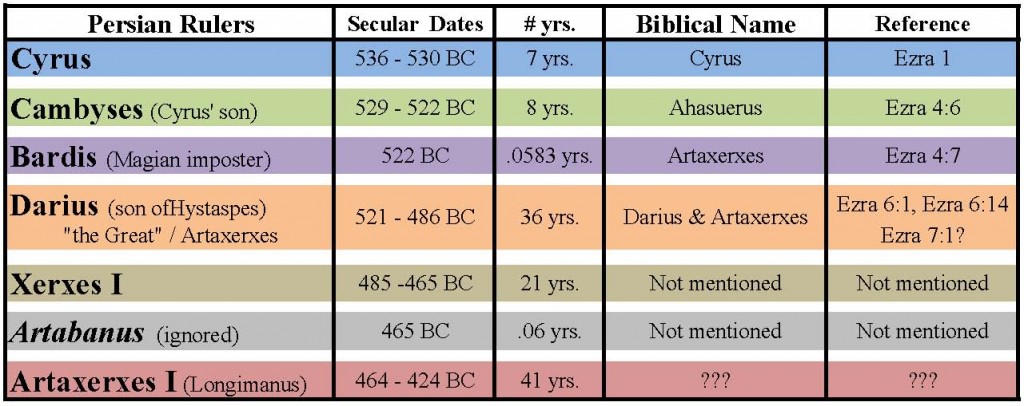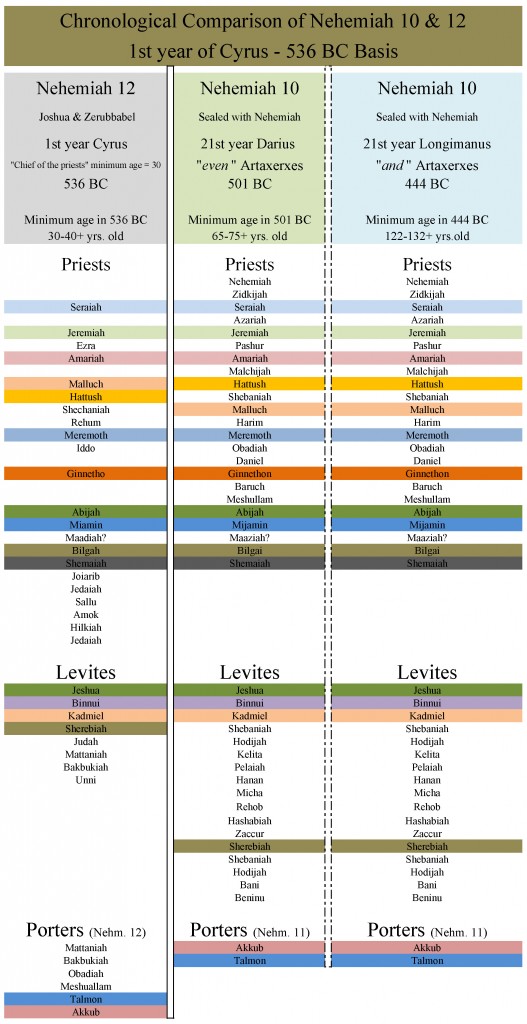Authors Note: This article is part of an ongoing series on the 2nd temple era chronology as it relates to the prophecy of Daniel’s Seventy Weeks.
Nehemiah: The Governor
In 520 BC YHWH gave Joshua and Zerubbabel a “commandment to restore and build Jerusalem.” (See my article Fifth Command for more information on the subject.) Four years later the temple in Jerusalem was completed but very little progress had been made in building the walls of the ancient citadel. The remnant of people who dwelt there was still being harassed by their enemies.
Back in Shushan, the winter palace of the Persian Kings, a Judean captive named Nehemiah was the cupbearer to king “Artaxerxes”. Nehemiah heard of the plight of his brethren in Jerusalem and set out to do something about it. After pouring his heart out to YHWH in prayer, Nehemiah petitioned king Artaxerxes to allow him to go up and repair the walls of Jerusalem. Artaxerxes granted his request and we learn later that Nehemiah also became governor (Tirshatha) of Jerusalem.
Most scholars today identify the Persian “Artaxerxes” in the book of Nehemiah as Artaxerxes Longimanus. If you have read my articles the Artaxerxes Assumption, or Ezra: Priest & Scribe you know why this identification is without a reasonable basis in the Biblical record. A close look at the information provided in the book of Nehemiah further adds to that conclusion.
In Nehemiah 5:14, it states that Nehemiah was appointed governor from the 20th to the 32nd year of “Artaxerxes”. This information allows us to limit our search for Nehemiah’s “Artaxerxes” to three Persian kings because only three ruled 32 years or longer than. Those kings are Darius, Longimanus, and Memnon. (Memnon ruled 46 yrs. but is not included in the list below. His rule commenced after Darius Nothus)

So which of these three Persian kings provides a reasonable basis to claim he is the “Artaxerxes” of Nehemiah? There are several pieces of evidence in the book of Nehemiah which give us the answer so let’s take a look:
- In Nehemiah 1:1 we find Nehemiah in the Shushan palace. For those familiar with the book of Esther you know that Shushan was the palace of Esther’s King. In my articles on the Queen of Persia I showed that in the most reasonable rendering of the Biblical evidence, Esther was the Queen of Darius Hystaspes, king of 127 provinces. This premise is further strengthened by an unusual statement in Neh. 2:6 (Artaxerxes is addressing Nehemiah)And the king said unto me, (the queen also sitting by him,) For how long shall thy journey be? and when wilt thou return?
- Nehemiah 12:25-26 shows a contemporaneous relationship between the porters and Joiakim (son of Jeshua the high priest), Nehemiah, and Ezra. This is important, because this places Nehemiah as a first generation contemporary of those who returned under the mandate of Cyrus in 536 BC.Nehemiah 12:25-26 2Mattaniah, and Bakbukiah, Obadiah, Meshullam, Talmon, Akkub, were porters keeping the ward at the thresholds of the gates. These were in the days of Joiakim the son of Jeshua, the son of Jozadak, and in the days of Nehemiah the governor, and of Ezra the priest, the scribe.
- Nehemiah 12:47 links the governorships of Zerubbabel and Nehemiah and their ministrations to the singers and porters.Nehemiah 12:47 – 13:1 47 And all Israel in the days of Zerubbabel, and in the days of Nehemiah, gave the portions of the singers and the porters, every day his portion: and they sanctified holy things unto the Levites; and the Levites sanctified them unto the children of Aaron.
- In Nehemiah 8 it describes the celebration of the first Feast of Tabernacles which took place after the wall was finished. (21st year of Artaxerxes) The text identifies those who partook:Nehemiah 8:17 17 And all the congregation of them that were come again out of the captivity made booths, and sat under the booths: for since the days of Jeshua the son of Nun unto that day had not the children of Israel done so. And there was very great gladness.
Notice it says “them that were come again out of the captivity”. The most reasonable reading of this implies these people were the same generation as those who came up with Joshua and Zerubbabel in 536 BC. This places them as the contemporary of Darius Hystaspes also known as Artaxerxes. - Further supporting the above is the lists of Nehemiah 10 & 12. In Nehemiah 12 it lists the priests and Levites “chiefs of their fathers” who came up out of the captivity with Joshua and Zerubbabel by the decree of Cyrus in 536 BC. Nehemiah 10 lists many of those same priests and Levites as still alive in the 21st year of “Artaxerxes”.
So which is the more reasonable explanation? These men were (at their youngest) 65-75 years old during the reign of Darius Hystaspes or they were (at their youngest) 122-132 years old during the reign of Artaxerxes Longimanus. Only one of these options does not strain the bounds of credibility. Please see the chart below for comparison.
In summary, it is clear that Nehemiah and Ezra were contemporaries of Darius Hystaspes, also known as Artaxerxes. Any other rendering of the chronology requires one to ignore the most reasonable and natural reading of the book of Nehemiah.
More Articles related to the prophecy of 70 Weeks and 2nd temple era chronology:
The “Artaxerxes” Assumption – The best kept secret of Old Testament chronology.
The Fifth Command – Why do prophecy teachers ignore it?
Ezra: Priest & Scribe – Part I – Defining “Artaxerxes” in the context of Ezra.
Ezra: Priest & Scribe – Part II – Ezra, Darius even “Artaxerxes”.
Nehemiah: The Governor– Nehemiah’s place in the 2nd temple chronology
Queen of Persia – Part I – Defining Esther is the context of the 2nd Temple era.
Queen of Persia – Part II – Defining Esther is the context of the 2nd Temple era.
A New Testament Cipher – The key to unlocking the prophecy of Daniel’s 70 Weeks.
Ezekiel’s 13th Month– Key to understanding Biblical “time” in the 2nd Temple era
6 milestones – Seventy Weeks – Defining the purpose of the Messiah within Daniel’s 70 “weeks”.
The Messiah Factors (Part I): Decoding 13 & 14 – Symbolism of the Messiah
The Messiah Factors (Part II): The Countdown – Proving Yeshua/Jesus is the Messiah promised in Daniel 9.




